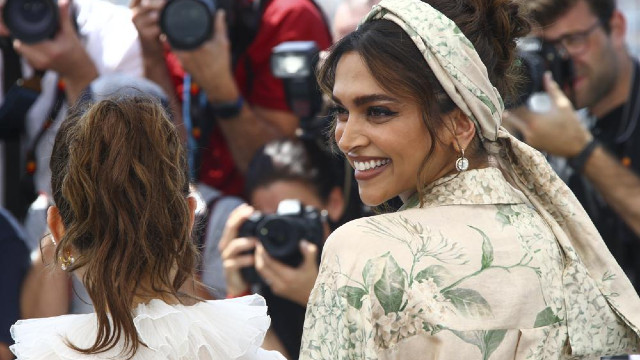The
Cannes Film Festival 2022
is on, and
Deepika Padukone
’s presence in the Competition jury this year creates scope for an interesting observation. Over the decades since the late auteur
Mrinal Sen
became the first Indian on the Cannes jury in 1982, there has been a shift in global perspective on what truly represents popular Indian arts as a whole and cinema in specific, and the fact seems underlined by the celebrity invited to be on the festival’s august panel at a particular point of time. Between Sen in 1982 and Padukone in 2022, the four decades have seen the Cannes jury invite filmmaker Mira Nair (1990), novelist Arundhati Roy (2000), actors Aishwarya Rai-Bachchan (2003), Nandita Das (2005) and Sharmila Tagore (2009), filmmaker
Shekhar Kapur
(2010) and actor
Vidya Balan
(2013). All of them have been global achievers. What’s interesting is how Cannes’ pick of Indian celebrities for jury duty has broadly tended to gravitate towards mainstream icons over the years. The reason would seem manifolds. The New Wave cinema, of which Sen was one of the founders in India, has long left its glory days behind — in fact, the depleted genre has not spawned a single Indian icon worth global stature for several years now. In contrast, an adequate amount of international limelight coming India’s way over the past two decades has been courtesy the output of the nation’s mainstream film industries, particularly Bollywood. Importantly, Sen’s was an era when aesthetic pre-eminence in cinema was a parameter of excellence. Arthouse cinema was revered even by those that did not wholly comprehend its nuances, and being cinematically cerebral was celebrated. Today, the cerebral has made way for the consumerist. Cannes as a festival has become far more a commercial venture than it was in Sen’s time. The gala is dominated by brands that drive the show, as well as the brand ambassadors. Padukone and most of the Bollywood stars on Cannes jury in recent years represent a very different culture in show business. Today, success as a film personality isn’t solely about achievement on screen. In the age of social media and consumerism, success as a film personality also lies in the ability to become a popular icon and a powerful brand. [caption id=“attachment_10697161” align=“alignnone” width=“300”]
 Deepika Padukone at Cannes 2022[/caption] If Sen’s inclusion on the Cannes jury of 1982 was more about the cerebral quotient of his cinema that aspect had a socio-political context, too. He was a Marxist, as was the leitmotif of his body of work. His cinematic idiom could be sombre and uncompromisingly provocative in a way contemporary Indian cinema and its celebrities hardly ever are. Sen is widely credited with ushering the New Wave in Indian films along with fellow Bengali titans
Ritwik Ghatak
,
Satyajit Ray
and Tapan Sinha. More than the others in that elite club, his cinema was consistently political in idiom. Was Cannes celebrating the power of Indian cinema to be political while inviting Sen on the jury in 1982? Possibly, if you consider his output as a filmmaker around that time. In 1982, Mrinal Sen would release Kharij starring Anjan Dutt, Mamata Shankar and Sreela Majumdar. The film was a social comment underlining class divide and society’s apathy towards the marginalised, through the story of the accidental death of a poor boy employed as a domestic help in a middle-class home. Kharij would be nominated for Golden Palm at Cannes a year later, and fetch Sen a Jury Prize. The film also won him two of the 18 National Film Awards he would win in his lifetime. Importantly, the film opened even as Sen was garnering international acclaim for his earlier release, Akaler Sandhane. Akaler Sandhane, featuring an ensemble cast toplined by Smita Patil, Dipankar Dey and Dhritiman Chatterjee, was a biting satire that highlighted the urban-rural chasm and hinterland poverty, through the story of a film unit that arrives in a remote village to make a feature film about famine. The film, a Silver Bear winner at Berlin 1981, went on to receive four National Awards. A year after representing India on the Cannes jury, in 1983, Sen would release Khandhar starring Shabana Azmi and Naseeruddin Shah. Considered one of the filmmaker’s most apolitical film, Khandhar addressed the crumbling of values among urban folk. These three films, releasing around the time of Sen’s Cannes sojourn as a jury member, came after he had already established his credentials as a titan with an oeuvre spanning decades and including such films as Neel Akasher Neechey, Baishey Shravan, Punascha, Abasheshe, Akash Kusum, Bhuvan Shome, Interview, Ek Adhuri Kahani, Calcutta 71, Padatik, Chorus, Mrigayaa, Oka Oori Katha, Parashuram, Ek Din Pratidin. Each of these films was an expression of concern and rage directed at a particular societal ill. Sen’s intent as a filmmaker committed to give interpretation to his socio-political angst would extend to later films, too, including Genesis, Ek Din Achanak, Mahaprithibi, Antareen and Aamar Bhuban. By the time Sen released his last film Aamar Bhuban in 2002, art cinema as a genre was buckling under the pressure of depleting avenues to find an audience and budgetary struggles. Incidentally, his final directorial effort starred Nandita Das, who would be invited to be on the Cannes jury three years later. Today, when cinematic excellence is invariably measured by the hundreds of crores a film might rake in at the box office, the unflinching New Wave aesthetics of Dadasaheb Phalke Award recipient Mrinal Sen no longer has ample space to grow and thrive. Cannes had to accommodate that changing trend, even as the festival’s annual hunt for the best in cinema goes on. Vinayak Chakravorty is a critic, columnist and film journalist based in Delhi-NCR. Read all the
Latest News
,
Trending News
,
Cricket News
,
Bollywood News
,
India News
and
Entertainment News
here. Follow us on
Facebook
,
Twitter
and
Instagram
.
Deepika Padukone at Cannes 2022[/caption] If Sen’s inclusion on the Cannes jury of 1982 was more about the cerebral quotient of his cinema that aspect had a socio-political context, too. He was a Marxist, as was the leitmotif of his body of work. His cinematic idiom could be sombre and uncompromisingly provocative in a way contemporary Indian cinema and its celebrities hardly ever are. Sen is widely credited with ushering the New Wave in Indian films along with fellow Bengali titans
Ritwik Ghatak
,
Satyajit Ray
and Tapan Sinha. More than the others in that elite club, his cinema was consistently political in idiom. Was Cannes celebrating the power of Indian cinema to be political while inviting Sen on the jury in 1982? Possibly, if you consider his output as a filmmaker around that time. In 1982, Mrinal Sen would release Kharij starring Anjan Dutt, Mamata Shankar and Sreela Majumdar. The film was a social comment underlining class divide and society’s apathy towards the marginalised, through the story of the accidental death of a poor boy employed as a domestic help in a middle-class home. Kharij would be nominated for Golden Palm at Cannes a year later, and fetch Sen a Jury Prize. The film also won him two of the 18 National Film Awards he would win in his lifetime. Importantly, the film opened even as Sen was garnering international acclaim for his earlier release, Akaler Sandhane. Akaler Sandhane, featuring an ensemble cast toplined by Smita Patil, Dipankar Dey and Dhritiman Chatterjee, was a biting satire that highlighted the urban-rural chasm and hinterland poverty, through the story of a film unit that arrives in a remote village to make a feature film about famine. The film, a Silver Bear winner at Berlin 1981, went on to receive four National Awards. A year after representing India on the Cannes jury, in 1983, Sen would release Khandhar starring Shabana Azmi and Naseeruddin Shah. Considered one of the filmmaker’s most apolitical film, Khandhar addressed the crumbling of values among urban folk. These three films, releasing around the time of Sen’s Cannes sojourn as a jury member, came after he had already established his credentials as a titan with an oeuvre spanning decades and including such films as Neel Akasher Neechey, Baishey Shravan, Punascha, Abasheshe, Akash Kusum, Bhuvan Shome, Interview, Ek Adhuri Kahani, Calcutta 71, Padatik, Chorus, Mrigayaa, Oka Oori Katha, Parashuram, Ek Din Pratidin. Each of these films was an expression of concern and rage directed at a particular societal ill. Sen’s intent as a filmmaker committed to give interpretation to his socio-political angst would extend to later films, too, including Genesis, Ek Din Achanak, Mahaprithibi, Antareen and Aamar Bhuban. By the time Sen released his last film Aamar Bhuban in 2002, art cinema as a genre was buckling under the pressure of depleting avenues to find an audience and budgetary struggles. Incidentally, his final directorial effort starred Nandita Das, who would be invited to be on the Cannes jury three years later. Today, when cinematic excellence is invariably measured by the hundreds of crores a film might rake in at the box office, the unflinching New Wave aesthetics of Dadasaheb Phalke Award recipient Mrinal Sen no longer has ample space to grow and thrive. Cannes had to accommodate that changing trend, even as the festival’s annual hunt for the best in cinema goes on. Vinayak Chakravorty is a critic, columnist and film journalist based in Delhi-NCR. Read all the
Latest News
,
Trending News
,
Cricket News
,
Bollywood News
,
India News
and
Entertainment News
here. Follow us on
Facebook
,
Twitter
and
Instagram
.
Mrinal Sen in 1982 to Deepika Padukone in 2022: Indian presence in Cannes jury goes cerebral to commercial
Vinayak Chakravorty
• May 20, 2022, 11:35:31 IST
Choice of Indian celebs on Cannes jury duty has gravitated towards mainstream icons over the years
Advertisement
)
End of Article